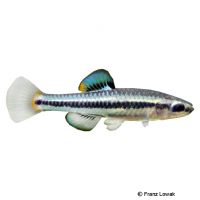Bluefin Killifish (Lucania goodei)
| Bluefin Killifish Lucania goodei | |
|---|---|
| Name | Bluefin Killifish |
| Name Lat. | Lucania goodei |
| Family | Topminnows and Killifishes |
| Family lat. | Fundulidae |
| Order | Killifishes & Livebearers |
| Order lat. | Cyprinodontiformes |
| Origin | North America |
| Habitat | Streams, ponds |
| Diet | Omnivore |
| pH | 6.5-8.0 |
| Behavior | Peaceful |
| Keeping | Group |
| Care Level | Moderate |
| Reproduction | Substrate spawner |
| Breeding | Moderately difficult |
| Life Span | 2-4 years |
| Protection | No |
| Metric Units | |
| Size | 4-6 cm |
| Temperature | 12-25 °C |
| Hardness | 5-20 °dH |
| Aquarium | 50 l |
| US Units | |
| Size | 1.6"-2.4" |
| Temperature | 54-77 °F |
| Hardness | 89-356 ppm |
| Aquarium | 15 gal |
Distribution and habitat
The range of the red-tailed carp is the southeastern United States, from Florida through South Carolina to eastern North Carolina. There they live in shallow, weedy, stagnant and slow-flowing waters, but also in the brackish water of estuaries.
Maintenance
The aquarium should have a dense border and background planting, with moss and fine-feathered plants, which serve as hiding and retreat possibilities as well as offer some free swimming space. A dark, sandy substrate covered with some foliage (sea almond tree, oak) and slightly shaded light (floating plants) is ideal.
No ammonia, ammonium and nitrite should be detectable, the nitrate value should not exceed 100 mg/l. To ensure the water quality and oxygen content, a filter and heater adapted to the aquarium size is required, as well as lighting for the species-appropriate day-night rhythm of the animals.
Diet
The food supply consists of live food, such as daphnia, cyclops, artemia, mysis, tubifex and red mosquito larvae, which are also accepted in frozen form without any problems, or a commercially available, frozen special food mixture supplemented with vegetable food such as algae leaves. Also high-quality dry food (pellets, granules) is usually well accepted after habituation.
It is recommended to feed small portions several times a day. Only as much should be fed as is eaten within a few minutes. Regular and varied feeding promotes health and increases resistance.
Behaviour and compatibility
Red-tailed carps should be kept in pairs or better in a group of 4-5 individuals. During the spawning season males occupy small territories, which they defend. Keeping several pairs or a group is recommended only in a larger and richly structured tank. They can be well socialized with other calm, not too large fish
Basically, only compatible fish species with similar demands on water quality and water temperature should be socialized.
Sex dimorphism
Adult males are slightly larger and more slender than females and have bright blue dorsal and anal fins, which are transparent in females.
Reproduction and breeding
Over several weeks the female spawns on plants, stones or sand individually up to 20 eggs daily, which are fertilized by the male. The parents do not perform any brood care. After about 2 weeks the young fish swim freely and are already sexually mature after about 2 months.
Fry must be fed several times a day with special rearing food (liquid or dust food, Artemia nauplii). In community tanks breeding is hardly possible, because the young fish are easy prey.
Important
In the summer months it is possible to keep them in the pond. They are not hardy and therefore not suitable for year-round keeping in the garden pond.
They show their most beautiful coloration by feeding with live food
The foliage (sea almond tree, oak, etc.) not only provides cover, but when rotting promotes the development of microorganisms, which are a valuable secondary food source.
The well-being of the fish should be monitored regularly. Temperature should be checked daily, pH, hardness and nitrate levels at least every 14 days. Regular partial water changes are recommended, even when contaminant levels have not yet reached the upper limit. Sudden changes in water quality should be avoided. Newly introduced fish must be accustomed slowly to the water in the aquarium.
Further literature can be found in your pet store.
References
Text: petdata; Image: Franz Lowak
Source: BMELV (1998): Tierschutzgutachten - Haltung von Zierfischen (Süßwasser); ENGELMANN (2005): Zootierhaltung - Tiere in menschlicher Obhut: Fische, Verlag Harri Deutsch
- Gemäß § 21 Abs. 5 Tierschutzgesetz idgF
